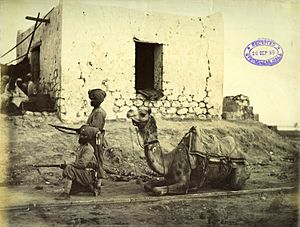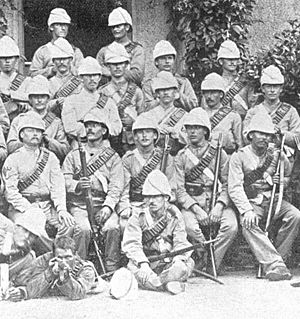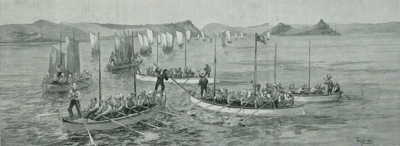Nile Expedition facts for kids
- Further information: Mahdist Sudan
The Nile Expedition (1884–1885) was a British mission. Its main goal was to rescue Major-General Charles George Gordon in Khartoum, Sudan. Gordon had been sent to Sudan to help Egyptian soldiers leave the area. This happened after the British decided to leave Sudan. A rebellion led by Mahommed Ahmed, who called himself the Mahdi, was growing strong.
A group of Canadians joined the British. They were experts at navigating small boats up the Nile River. This Nile Expedition was the first time Canadians went overseas for a British conflict. These Canadian "Nile Voyageurs" were civilians, not soldiers, and did not wear uniforms.

General Garnet Wolseley led the expedition. Later, Commander Herbert Stewart was badly hurt. Brigadier-General Charles William Wilson then took charge of a group of about 1,400 men. Wilson's group reached Khartoum on 28 January 1885. They arrived on two Nile steamers.
Sadly, they were two days too late. Khartoum had been captured by the Mahdists on 26 January. The entire army in the city, along with Gordon and 4,000 civilians, had been killed. Some people blamed Wilson for the delay. Others said the blame should be shared, even with Wolseley. The public in England also blamed Prime Minister William Gladstone. Some historians also say General Gordon was partly responsible. He had refused to leave when he still could.
Contents
Why the Nile Expedition Happened
The United Kingdom of Great Britain and Ireland did not want to fight a costly war in Sudan. So, in December 1883, they told Egypt to stop ruling Sudan. The British government asked General Gordon to go to Khartoum. His job was to help Egyptian soldiers and their families leave safely.
Gordon arrived in Khartoum on 18 February 1884. He immediately started sending women, children, and wounded soldiers back to Egypt. The situation in Sudan was getting worse. The southern part of the country was in danger of being cut off by the Mahdist army. Britain pulled its troops out of Sudan. Soon, Khartoum was the only place still under British control.
Gordon disagreed with the British government's plan to leave Sudan. He believed the Mahdists needed to be stopped. He feared they might take over Egypt next. This was because the Mahdi claimed to rule all Islamic lands. General Gordon decided to stay and defend Khartoum. He had a force of 6,000 men.
On 18 March 1884, the Mahdist army began to surround the city. They stopped boats on the river and cut the telegraph line to Cairo. Khartoum was cut off from new supplies, which caused food shortages. However, they could still send messages using messengers. In August 1884, the British public put pressure on the government. Because of this, the government changed its mind. They decided to send a rescue force to Khartoum.
Getting the Rescue Team Ready
General Garnet Wolseley was put in charge of the expedition. He had fought in many wars, including the Crimean War and in Canada. His force included officers and soldiers from British cavalry regiments.
Wolseley decided the best way to reach Khartoum was to travel up the Nile. He had a good experience with Canadian boatmen before. This was during his trip along the Red River in Canada. So, he asked the Governor General of Canada, the Marquess of Lansdowne, for help. He wanted to recruit Canadian voyageurs to guide the boats on the Nile.
Wolseley asked that Lieutenant-Colonel Frederick C. Denison lead them. Denison had worked with Wolseley before. The Prime Minister of Canada, John A. Macdonald, agreed. He made sure the voyageurs were volunteers and that Britain would pay them. Denison quickly gathered the men. On 15 September 1884, just 24 days after the request, 386 voyageurs sailed for Egypt.
These Canadians were known as the Nile Voyageurs. Many of them used to transport logs down rivers in Canada. Eighty-six of the voyageurs were Indigenous people. Most were from the Caughnawaga and Ojibwa communities.
The Journey Up the Nile
On 7 October 1884, the Canadians reached Alexandria by ship. They then traveled up the Nile using small steam launch boats and trains. By 26 October 1884, the Canadians met Wolseley and his 5,400 soldiers at Wadi Halfa. In November, they reached the first of six rapids. They began to move their boats up these fast-moving waters.
The experienced voyageurs made the expedition move faster. Wolseley chose special boats for the journey. These were modified Royal Navy whalers. They were about 10 meters (33 feet) long and 2 meters (6.5 feet) wide. They could carry twelve men and enough supplies for 100 days.
In mid-November, General Gordon sent a message. He said he could only hold out for 40 more days. The expedition faced attacks from rebels at Abu Klea and Abu Cru. But they fought off these attacks both times. Moving up the river was slow. Often, the boats had to be pulled by ropes from the shore. Sometimes, several crews were needed to pull one boat. The voyageurs were stationed at difficult parts of the river. This way, each group became very good at handling their section of the water.
Wolseley realized time was running out for Gordon. So, he split his force into two groups. He sent 2,400 men by camel across 280 kilometers (174 miles) of desert. This was a shortcut to avoid a large bend in the Nile. The other 3,000 soldiers continued up the river.
The Canadians' six-month contracts were ending. They were asked to sign up again. Only 86 voyageurs, including their leader Denison, agreed to stay. The others went back to Canada. They hoped to be home for the spring logging season. This did not stop the expedition. The hardest parts of the river were already behind them. Also, fewer soldiers were traveling by river, so fewer Canadians were needed. Denison and his men kept guiding the boats up the river.
General Gordon's last journal entry was on 14 December 1884. He wrote that if the rescue force did not arrive in ten days, the city might fall. He said he had done his best for his country.
On 26 January 1885, Khartoum fell to the Mahdist army of 50,000 men. The Nile was shallow enough to cross at that time of year. The Mahdists attacked the city's weak river defenses. The entire army in the city was killed, including General Gordon.
Two days later, two British armed steamers arrived near the city. They were carrying about 140 British and local troops. Brigadier-General Wilson, who was leading them, saw that the city had fallen. He ordered his boats to turn around and go back down the river to Wolseley. This was the closest the rescue team got to Khartoum.
After Khartoum Fell
The Mahdists were confident after their win at the Siege of Khartoum. They fought against British efforts to move up the Nile. On 10 February 1885, the Mahdists defended a strong position at Kirbekan. They hoped to stop the main British group still coming up the river. These battles happened about two weeks after Khartoum fell. At Kirbekan, the British won the fight. However, their commander, General William Earle, was killed.
The fall of Khartoum and the deaths there led to many messages between Wolseley and London. On 7 February 1885, London told Wolseley not to retreat down the Nile. But Wolseley was worried. He felt he did not have enough soldiers to defeat the Mahdi after Khartoum fell. They thought about pausing the mission for several months. This would allow more British soldiers to arrive in Egypt.
The Panjdeh incident happened on 29 March 1885. This was a conflict with Russia in Asia. It gave the British government a reason to pull Wolseley's force back to Egypt and then home. This ended Britain's involvement in the region. After Khartoum fell and the British troops left, Muhammad Ahmad controlled all of Sudan. He created an Islamic state based on Sharia law. He died less than six months later. His state continued, but Britain re-conquered Sudan. This happened in a campaign from 1895 to 1898, led by Lord Kitchener.
Legacy of the Expedition
On 17 April 1885, the Canadian group sailed home from Alexandria. Sixteen Canadians had died during the expedition. They are remembered in Canada's Peace Tower. This tower honors all Canadians who died in wars. Wolseley wrote a letter to the Canadian Governor General. He praised the Canadians' service. The British Parliament also thanked them for their efforts.
A collection of records from the expedition was put together by C.P. Stacey. It was published in 1959.
Charles Lewis Shaw was one of the journalists who covered the expedition. He worked for the Winnipeg Times newspaper. His book, "Nile Voyageur," was once famous. Copies of it are now very rare.
A special plaque was put up in 1966. It is called "Nile Voyageurs 1884–85." You can find it at Kitchissippi Lookout in Ottawa, Canada.
See also
- Khartoum, a 1966 film
- The Four Feathers, a 1939 film
- The Four Feathers, a 2002 film
- Pith helmet



